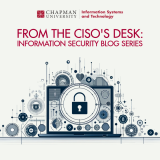
Unexpected MFA Codes and What to Do About Them
January 29, 2024
As we navigate the complexities of the online world, a new security challenge has emerged: the unsolicited receipt of Multi-Factor Authentication (MFA) requests. This occurrence is a significant indicator that someone might be attempting unauthorized access to your online accounts.
MFA is a way of verifying your identity when you sign in to an online account by requiring two or more authentication methods. Here are the general steps of authentication when using MFA:
- Enter your username and password as usual on the sign-in page of the account or app you want to access.
- Choose your second factor from the available options, such as an authenticator app, a text message, a phone call, a security key, or an email account.
- Provide the second factor to the account or app, such as entering a two digit number.
- If the second factor is verified, you are signed in to the account or app.
Receiving an MFA request without initiating a login process suggests that your account credentials may have been compromised. This could occur through various means, such as phishing attacks, data breaches, or even more sophisticated cyber threats.
Immediate Steps to Secure Your Accounts If You Receive Unsolicited MFA Requests
- Prompt Password Change: The first action should be changing your account’s password. Ensure you do this through the official website or application.
- Unique Passwords for Each Account: Avoid the pitfall of password reuse. If your compromised password is used on other accounts, change it everywhere.
- Adopt Stronger MFA Methods: While SMS-based authentication is prevalent, it is susceptible to interception. Opt for more secure methods like the authentication app.
A Call for Digital Vigilance
The unsolicited arrival of an MFA request is not just an annoyance but a serious indication that your online security is at risk. Recognizing this as a signal to bolster your digital defenses is essential. Using unique passwords for each account and opting for more secure forms of MFA are vital steps in safeguarding your digital presence. Understanding the risks and taking decisive action can significantly reduce the likelihood of falling victim to digital threats.
Stay safe and stay informed!
Chapman University Information Systems and Technology (IS&T)

